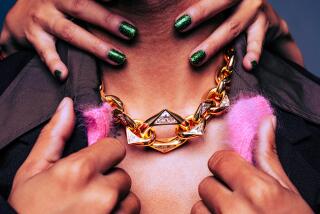All That Glitters
- Share via
There are several unlikely reasons to buy fine jewelry right now: toxic oceans and taxes.
Pollution is killing off the large oysters that produce some types of cultured pearls, says Gianmaria Buccellati, a Milan jeweler with a store in Beverly Hills.
At the same time, pearls--the oversize South Seas variety in particular--have become increasingly popular. First Lady Barbara Bush, who wears her costume-jewelry version on many public occasions, influenced the trend.
Because large pearls are scarce, prices have gone up three times in the last two years, Buccellati says. He predicts prices will continue to escalate.
A choker of 12-millimeter South Seas pearls sells for $120,000 and up. A strand of rare gray South Seas pearls sells for $510,000 at Harry Winston, the New York-based fine jewelry store that opened a branch on Rodeo Drive this month.
Not all pearls command astronomical prices. Some, in fact, are bargains this season.
Smaller, 6- to 8-millimeter pearls have remained stable in price, says Devin Macnow, spokesman for the Cultured Pearl Assn. “That’s where the best buys are.”
For example, 7-millimeter pearls in longer, more versatile lengths, especially the 32-inch strands, range from $2,500 to $3,500.
The demand isn’t limited to real pearls. At Kenneth Jay Lane, a costume jewelry store that carries the triple strand favored by Barbara Bush, faux pearls are the foundation of the business. Prices start at $25, for earrings.
“Pearls just won’t die,” says Melissa Parker, vice president of marketing and retail operations for Ciro, which owns Ciro and Kenneth Jay Lane stores.
The newest costume looks are the same exaggerated styles in demand in the fine jewelry market. “Bigger-millimeter pearls--as many as 18 millimeters,” Parker notes. “I don’t see demand tapering.”
For the holidays, the firm is featuring gray, gold and black pearl chokers. Spring will bring more colored pearls, including beige and pink, she predicts.
Diamonds are in demand this holiday season, too. And, as with pearls, the preference is for rare varieties. “People are looking for colored diamonds--pink, gold, canary, blue,” says Ronald Winston, president of Harry Winston.
“Fancy, colored diamonds have gone up five to eight times in price over the last four or five years,” he says.
Retail prices for white diamonds went up about 20% this year, as a result of increases by De Beers Consolidated Mines, the world’s biggest diamond producer, says Charles Krypell, a New York jewelry designer. A good, one-carat diamond costs $4,000 to $5,000, he says.
Krypell showed his precious stone jewelry collection at XIV Karats, where gems are sold at discount prices, in Beverly Hills on Thursday.
In the past two months, jewelry designer Katheryn Post, who works with real and imitation stones, has seen a flip-flop in what is selling. Instead of real diamonds, her clients want cubic zirconia, stones that look like real diamonds but cost about one-tenth the price.
“The people who are buying cubic zirconia don’t want anyone to know anything has changed, even though everyone is affected by the economy,” Post says.
Although jewelry retailers are reluctant to talk about the effect of the economic slump on their businesses, most admit Christmas sales, which typically add up to 40% of the industry’s $20 billion in annual revenue, have been slow this year.
“If it is a slow Christmas, it will be the third soft Christmas in a row,” says Joseph Thompson, editor-in-chief of Modern Jeweler magazine.
“The jewelry industry is not unhealthy, it’s just reflecting the general trend in retail.”
For the consumer, he says, “there may be some bargains out there. Retailers are trying to avoid a repeat of the recession of 1982.”
Thompson points out that foreign money is buoying prices. Buyers from Europe and the Far East have been scooping up cut and uncut stones, as well as finished jewelry.
Prices for quality rubies are about $4,500 to $5,500 per carat; emeralds are $7,000 to $8,000; sapphires range from $3,000 to $3,500. Lower-quality stones with some flaws run about half these prices.
Anyone considering a major jewelry purchase might want to make it soon for one reason: the new luxury tax.
Beginning Jan. 1, a 10% excise tax will be imposed on the portion of the retail price in excess of $10,000. A $15,000 bauble, for example, will have $500 tacked on to its price.
Some people in the business remember a similar tax during World War II. It was reduced in the ‘50s and finally eliminated in 1965.
Larry French, vice president of Van Cleef & Arpels, recalls:
“Was it great? No. But people still have birthdays and anniversaries. It’s corny, but true; people still fall in love and we exist on the concept of love.”






